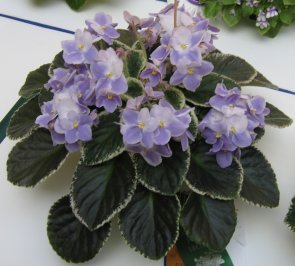Grooming
 1.
Remove dying or dead foliage and blossoms.
1.
Remove dying or dead foliage and blossoms.
2. Rotate plants one-quarter turn at intervals to assure even growth.
3. Remove suckers.
4. Remove dust and soil particles from foliage with a soft, natural bristle brush.
Just as almost everyone likes to practise good care of himself or herself with proper food, sleep, etc., so a good plant grower provides good care to his or her plants. This basic care creates a healthy, contented individual and a healthy, contented plant. There is always someone on the block who does a little extra in the way of grooming who then radiates his/her good health and contentment better than the average. An African violet grown by a good groomer will look bettter than an equally healthy plant grown by someone more casual.
Grooming is not complex and well worth the few extra moments.
Always, as we mentioned earlier, remove dead or dying foliage and flowers. Watch that outer row of leaves. These leaves start to fade long before they die and removing faded outer rows gives a better looking plant. Old outer rows are often smaller than the next row in and upset the proportions of the plant. Also remove suckers, those tiny plantlets that sometimes appear in the leaf axils, as soon as they are big enough to handle. As they grow they distort the plant's symmetry. You can often use the sucker as propagating material. If a leaf is growing out of position, gently move it to its proper place and hold it there with small stakes until it shows signs of staying there. Rotate your plants one quarter turn at least each time you water. Some even do this daily. Plants that stay stationary lean towards the light source.
Keep your plants free of dust and soil particles. Household dust settles on the leaves as it does on your coffee table. You likely know what the coffee table would look like if you did not dust it. The common tool for dusting is a soft, natural bristle brush such as a pig bristle pastry brush or a sable hair artist's brush. Never use a brush with artificial bristles. Even the softest artificial bristles have blunt ends which can injure the leaf surface. Gently stroke dust or spilt soil off the leaves.
Some good groomers take the extra care of damp-wiping the leaves with a moist natural sea sponge. The leaves may also be rinsed with water at 21 degrees C. (70 degrees F.) and the excess on the leaves wiped up with a natural sea sponge. Take care if you do this. Light shining on excess water can mark the leaves.
Following these simple, general rules will make your plants look much spiffier than an equally healthy collection that did not get the extra attention.


